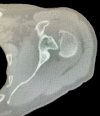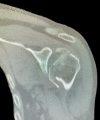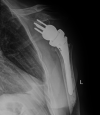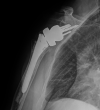Bilateral Posterior Four-Part Fracture-Dislocation of the Proximal Humerus After First-Time Seizure
- PMID: 34650863
- PMCID: PMC8487633
- DOI: 10.7759/cureus.17688
Bilateral Posterior Four-Part Fracture-Dislocation of the Proximal Humerus After First-Time Seizure
Abstract
This report presents a previously undescribed case and treatment of bilateral four-part proximal humerus (PH) fracture-dislocations presented in a 61-year-old Caucasian male patient following a first-time seizure episode. The patient was treated with bilateral reverse total shoulder arthroplasty due to pre-existing glenohumeral arthritis and rotator cuff atrophy. The surgery was successful, and the patient's postoperative recovery was uneventful. Fractures of the proximal humerus are a relatively common adult osteoporotic fracture; however, posterior fracture-dislocations of the PH, frequently related to motor vehicle accidents, seizures, or electrical shock, are remarkably scarce. A treatment algorithm for these injuries is lacking.
Keywords: bilateral proximal humerus fracture; bilateral shoulder arthroplasty; bilateral shoulder fracture-dislocation; four part fracture-dislocation; posterior dislocation of the shoulder; proximal humerus fracture; proximal humerus fracture-dislocation; reverse total shoulder arthroplasty; rtsa; seizure.
Copyright © 2021, Murphy et al.
Conflict of interest statement
The authors have declared that no competing interests exist.
Figures










Similar articles
-
Single-Stage Bilateral Reverse Shoulder Arthroplasty for a Bilateral Four-Part Fracture Dislocation of the Proximal Humerus in an Elderly Patient: A Case Report.Cureus. 2023 Nov 18;15(11):e49002. doi: 10.7759/cureus.49002. eCollection 2023 Nov. Cureus. 2023. PMID: 38111397 Free PMC article.
-
Single-stage bilateral reverse total shoulder arthroplasty for bilateral posterior shoulder fracture-dislocation following seizure: A case report.Int J Surg Case Rep. 2020;73:298-302. doi: 10.1016/j.ijscr.2020.07.037. Epub 2020 Jul 15. Int J Surg Case Rep. 2020. PMID: 32731176 Free PMC article.
-
Reverse Total Shoulder Arthroplasty for Geriatric Proximal Humerus Fracture Dislocation With Concomitant Nerve Injury.Geriatr Orthop Surg Rehabil. 2019 Jun 10;10:2151459319855318. doi: 10.1177/2151459319855318. eCollection 2019. Geriatr Orthop Surg Rehabil. 2019. PMID: 31218093 Free PMC article.
-
Bilateral posterior fracture-dislocation of the shoulders following epileptic seizures: a case report and review of the literature.BMC Res Notes. 2015 Nov 23;8:704. doi: 10.1186/s13104-015-1674-y. BMC Res Notes. 2015. PMID: 26597040 Free PMC article. Review.
-
Intrathoracic fracture-dislocation of the proximal humerus treated with rib fixation and shoulder arthroplasty.Am J Orthop (Belle Mead NJ). 2014 Apr;43(4):E74-8. Am J Orthop (Belle Mead NJ). 2014. PMID: 24730008 Review.
Cited by
-
Bilateral Locked Posterior Fracture-Dislocation of the Shoulder After Epileptic Seizures Secondary to Cavernous Hemangioma: A Case Report and Literature Review.Am J Case Rep. 2023 Jun 19;24:e940141. doi: 10.12659/AJCR.940141. Am J Case Rep. 2023. PMID: 37337276 Free PMC article. Review.
-
Single-Stage Bilateral Reverse Shoulder Arthroplasty for a Bilateral Four-Part Fracture Dislocation of the Proximal Humerus in an Elderly Patient: A Case Report.Cureus. 2023 Nov 18;15(11):e49002. doi: 10.7759/cureus.49002. eCollection 2023 Nov. Cureus. 2023. PMID: 38111397 Free PMC article.
-
Single-stage bilateral uncemented reverse shoulder arthroplasty for traumatic proximal humerus fractures: a case report.JSES Rev Rep Tech. 2024 May 6;4(3):504-510. doi: 10.1016/j.xrrt.2024.04.009. eCollection 2024 Aug. JSES Rev Rep Tech. 2024. PMID: 39157217 Free PMC article. No abstract available.
-
Bilateral locked posterior shoulder dislocation overlooked for 15 months treated with the modified McLaughlin procedure: A case report.Jt Dis Relat Surg. 2023;34(1):226-233. doi: 10.52312/jdrs.2023.869. Epub 2022 Dec 27. Jt Dis Relat Surg. 2023. PMID: 36700287 Free PMC article.
-
One-step Bilateral Reverse Shoulder Replacement for Posterior Fracture-dislocation in a Young Alcoholic.J Orthop Case Rep. 2022;12(5):11-14. doi: 10.13107/jocr.2022.v12.i05.2794. J Orthop Case Rep. 2022. PMID: 36660149 Free PMC article.
References
-
- Epidemiology of adult fractures: a review. Court-Brown CM, Caesar B. Injury. 2006;37:691–697. - PubMed
-
- Posterior shoulder instability. Steinmann SP. Arthroscopy. 2003;19:102–105. - PubMed
-
- Bilateral posterior shoulder dislocation: the importance of the axillary radiographic view. Clough TM, Bale RS. Eur J Emerg Med. 2001;8:161–163. - PubMed
-
- Miller MD, Thompson SR. Philadelphia: Elsevier; 2016. Miller’s Review of Orthopaedics.
-
- Bilateral posterior four-part fracture-dislocations of the shoulders following electric shock: a case report and literature review. Cooke SJ, Hackney RG. Inj Extra. 2005;36:90–95.
Publication types
LinkOut - more resources
Full Text Sources
